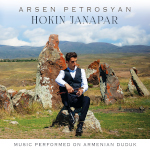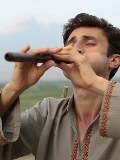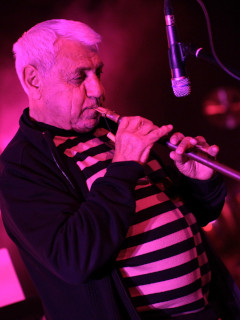


The duduk (/duːˈduːk/ doo-DOOK; Armenian: դուդուկ IPA: [duˈduk]) or tsiranapogh (Armenian: ծիրանափող, meaning “apricot-made wind instrument”), is an ancient Armenian double reed woodwind instrument made of apricot wood. It is indigenous to Armenia. Variations of the Armenian duduk appear throughout the Caucasus and the Middle East, including Azerbaijan, Georgia, Russia, Turkey, and Iran. It is commonly played in pairs: while the first player plays the melody, the second plays a steady drone called dum, and the sound of the two instruments together creates a richer, more haunting sound.

The unflattened reed and cylindrical body produce a sound closer to the English horn than the oboe or bassoon. Unlike other double reed instruments like the oboe or shawm, the duduk has a very large reed proportional to its size.
UNESCO proclaimed the Armenian duduk and its music as a Masterpiece of the Intangible Heritage of Humanity in 2005 and inscribed it in 2008. Duduk music has been used in a number of films, most notably in The Russia House and Gladiator.
The word düdük is of Turkish origin (Ottoman Turkish: دودوك düdük), itself derived from Persian tutak. In Armenia, the instrument is also known as tsiranapogh (ծիրանափող).
This instrument is not to be confused with the northwestern Bulgarian folk instrument of the same name (see below, Balkan duduk). Similar instruments used in other parts of Western Asia are the mey and balaban.
The duduk is a double reed instrument with ancient origins, having existed since at least the fifth century, while there are Armenian scholars who believe it existed more than 1,500 years before that. The earliest instruments similar to the duduk's present form are made of bone or entirely of cane. Today, the duduk is exclusively made of wood with a large double reed, with the body made from aged apricot wood.
The particular tuning depends heavily on the region in which it is played. In the twentieth century, the Armenian duduk began to be standardized diatonic in scale and single-octave in range. Accidentals, or chromatics are achieved using fingering techniques. The instrument's body also has different lengths depending upon the range of the instrument and region. The reed (Armenian: եղեգն, eġegn), is made from one or two pieces of cane in a duck-bill type assembly. Unlike other double-reed instruments, the reed is quite wide, helping to give the duduk both its unique, mournful sound, as well as its remarkable breath requirements. The duduk player is called dudukahar (դուդուկահար) in Armenian.
The performer uses air stored in their cheeks to keep playing the instrument while they inhale air into their lungs. This "circular" breathing technique is commonly used with all the double-reed instruments in the Middle East.
Duduk "is invariably played with the accompaniment of a second dum duduk, which gives the music an energy and tonic atmosphere, changing the scale harmoniously with the principal duduk."
Armenian musicologists cite evidence of the duduk's use as early as 1200 BC, though Western scholars suggest it is 1,500 years old. Variants of the duduk can be found in Armenia and the Caucasus. The history of the Armenian duduk music is dated to the reign of the Armenian king Tigran the Great, who reigned from 95–55 B.C. According to ethnomusicologist Dr. Jonathan McCollum, the instrument is depicted in numerous Armenian manuscripts of the Middle Ages, and is "actually the only truly Armenian instrument that's survived through history, and as such is a symbol of Armenian national identity ... The most important quality of the duduk is its ability to express the language dialectic and mood of the Armenian language, which is often the most challenging quality to a duduk player."
While "duduk" most commonly refers to the double reed instrument described on this page, by coincidence there is a different instrument of the same name played in northwestern Bulgaria. This is a blocked-end flute resembling the Serbian frula, known also as kaval or kavalče in a part of Macedonia, and as duduk (дудук) in northwest Bulgaria. Made of maple or other wood, it comes in two sizes: 700–780 millimetres (28–31 in) and 240–400 millimetres (9.4–15.7 in) (duduce). The blocked end is flat. Playing this type of duduk is fairly straightforward and easy, and its sound is clean and pleasant.
The sound of the duduk has become known to wider audiences through its use in popular film soundtracks. Starting with Peter Gabriel's score for Martin Scorsese's The Last Temptation of Christ, the duduk's archaic and mournful sound has been employed in a variety of genres to depict such moods. Djivan Gasparyan played the duduk in Gladiator, Syriana, and Blood Diamond, among others. It was also used extensively in Battlestar Galactica. In the TV series Avatar: The Last Airbender, its computer-altered sound was given to the fictitious Tsungi horn, most notably played by Iroh and often being featured in the show's soundtrack. With many of the members who worked on ATLA now working on The Dragon Prince, the duduk regularly appears in its soundtrack as well. The sound of the duduk was also used in The Chronicles of Narnia: The Lion, the Witch and the Wardrobe for a lullaby which Mr. Tumnus plays on a fictitious double flute and in the theme song of the Dothraki clan during the TV adaptation Game of Thrones.
The 2010 Eurovision Song Contest entry from Armenia "Apricot Stone", which finished 7th in the final, featured prominent duduk played by Djivan Gasparyan.

Text is available under the Creative Commons Attribution-ShareAlike License.
Date: June 2021.
Photo Credits:
(1) Armenian Duduk,
(2) Djivan Gasparyan
(by Wikimedia Commons);
(3)-(4) Arsen Petrosyan,
(5) A.G.A Trio,
(6) Vardan Hovanissian
(unknown/website).